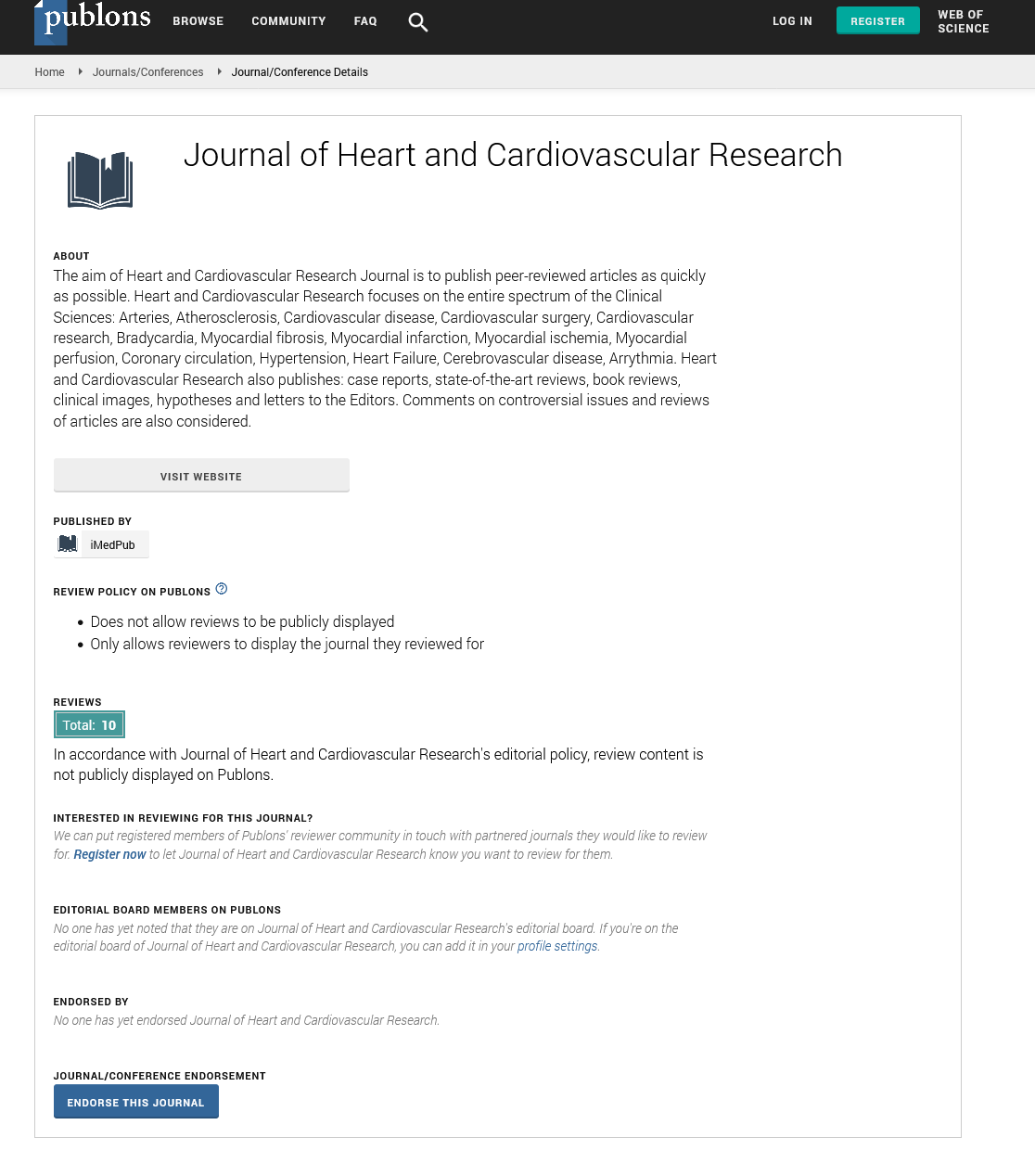ISSN : ISSN: 2576-1455
Journal of Heart and Cardiovascular Research
Usefulness of Google Forms platform to improve communication in acute coronary syndromes in a health care system
22nd International Conference on New Horizons in Cardiology & Cardiologists Education
March 07-08, 2019 Berlin, Germany
Bruno L R Faillace, Adriano O Tamazato, Leonardo Coelhor,Evandro K P Ribeiro, Alexandre R Sposito, Fabio Conejo, Roger R Godinho and Rodrigo B Esper
Sancta Maggiore Hospital, Brazil
ScientificTracks Abstracts: J Heart Cardiovasc Res
DOI: 10.21767/2576-1455-C1-002
Abstract
Statement: Telemedicine is an important tool that may facilitate the communication between the emergency room (ER) and the reference interventional cardiology team to improve the quality of treatment in acute coronary syndromes (ACS) scenario.
Methodology & Theoretical Orientation: In a health care system with 8 hospitals, 6 ER departments and one reference cardiac laboratory catheterization, a questionnaire was developed using a Google Forms platform that contains the administrative and medical patient’s information, ER phone number, and type of ACS. The interventional cardiology team receives and visualizes at the same time the answers of the Google Forms in a table. After reviewing the patient case using the same ER electronic medical record, the interventional team makes a phone contact to the ER physicians, discuss the case and evaluates the possibility of performing an immediately coronarography. All patients with ACS were added in the Google Forms platform.
Findings: A number of 1365 consecutive patients were included with ACS from September 2017 to October 2018. Of these, 1096 individuals were diagnosed with non-ST elevation myocardial infarction (NSTEMI) and 269 with ST elevation myocardial infarction (STEMI). Mean age was 72 years. After the discussion, 927 were directly referred for coronary angiography and 424 were to be evaluated and monitored by the cardiology team to decide the stratification strategy. The average time from ER entrance to CathLab was 2040 minutes before the implementation of the Google Forms in ACS admission. After the introduction of this protocol, the time fell to 449 minutes.
Conclusion & Significance: The Google Forms platform can be a useful tool to improve communication between the emergency department and the interventional cardiology team, and can optimize the treatment of the ACS patients.
Recent Publications
1. Faillace B L R, Ribeiro H B, Campos C M, Truffa A A M, Bernardi F L, Oliveira M D P, Mariani J Jr., Marchini J F, Tarasoutchi F and Lemos P A (2017) Potential of transcatheter aortic valve replacement to improve post-procedure renal function. Cardiovasc Revasc Med. 18(7):507- 511.
2. Bruno L R Faillace, Micheli Z Galon, Marcos Danillo P Oliveira, Guy F A Prado Jr., Adriano A M Truffa, Expedito E Ribeiro and Pedro A Lemos (2015) Left main compression by a giant aneurysm of the left sinus of valsalva: an extremely rare reason for myocardial infarction and cardiogenic shock. Case Rep Cardiol.2015:703646. doi: 10.1155/2015/703646.
3. Marcos Danillo Peixoto Oliveira, Expedito E Ribeiro, Carlos M Campos, Henrique B Ribeiro, Bruno L R Faillace, Augusto C Lopes, Rodrigo B Esper, George X Meirelles, Marco A Perin, Alexandre Abizaid and Pedro A Lemos (2015) Four-year clinical follow-up of the first-in-man randomized comparison of a novel sirolimus eluting stent with abluminal biodegradable polymer and ultra-thin strut cobalt-chromium alloy: the INSPIRON-I trial. Cardiovasc Diagn Ther. 5(4):264-70.
4. Biselli B, Ulhoa M B, Faillace B L R, Pinton F A, Escalante J P, Bacal F, Issa V S, Ayub Ferreira S M, Lemos Neto P A and Bocchi E A (2013) Cardiogenic shock after traumatic coronary hematoma. European Journal of Heart Failure 1:S331-S331.
Biography
Bruno L R Faillace has his expertise in Interventional Cardiology. He is a Brazilian Physician who has completed his training in Clinical and Interventional Cardiology at the Heart Institute of São Paulo, Brazil. Since college, his research line has always been in the cardiology area. Currently, he works at Sancta Maggiore Hospital in São Paulo and has been emerging among the new generation of interventional cardiologists at the national setting.
E-mail: brunolrfaillace@gmail.com
Google Scholar citation report
Citations : 34
Journal of Heart and Cardiovascular Research received 34 citations as per Google Scholar report
Journal of Heart and Cardiovascular Research peer review process verified at publons
Abstracted/Indexed in
- Google Scholar
- Sherpa Romeo
- China National Knowledge Infrastructure (CNKI)
- Publons
Open Access Journals
- Aquaculture & Veterinary Science
- Chemistry & Chemical Sciences
- Clinical Sciences
- Engineering
- General Science
- Genetics & Molecular Biology
- Health Care & Nursing
- Immunology & Microbiology
- Materials Science
- Mathematics & Physics
- Medical Sciences
- Neurology & Psychiatry
- Oncology & Cancer Science
- Pharmaceutical Sciences
